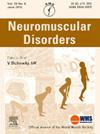Evaluation of dynamin 2 knockdown as a therapeutic strategy for RYR1 related myopathy
IF 2.7
4区 医学
Q2 CLINICAL NEUROLOGY
引用次数: 0
Abstract
RYR1 congenital myopathies, due to pathogenic variants in the RYR1 gene, are the most common subtype of nondystrophic myopathy. At present, there are no therapies for this condition. RYR1 myopathies share features with centronuclear myopathy (CNM), as RYR1 dysfunction is an important common pathologic endpoint of these conditions. Knockdown of dynamin 2 (DNM2) using an antisense oligonucleotide based strategy has shown efficacy in mouse models of CNM, including restoration of RYR1 function. Based on this, we sought to test whether Dnm2 knockdown could also ameliorate the phenotype of a mouse model of recessive RYR1 congenital myopathy, which exhibits a marked reduction in Ryr1 expression and function. To accomplish this, we administered an antisense oligonucleotide (ASO) targeting Dnm2 RNA or a scrambled ASO to a mouse model of the disease, and then measured the impact on multiple functional and pathologic endpoints. While we successfully achieved Dnm2 RNA knockdown with this treatment, no benefit was observed in any parameters measured. We thus conclude that lowering DNM2 transcript levels are unlikely to be a promising strategy for treating RYR1 congenital myopathy.
动力蛋白2敲低作为RYR1相关肌病治疗策略的评估
由于RYR1基因的致病变异,RYR1先天性肌病是最常见的非营养不良性肌病亚型。目前,还没有治疗这种疾病的方法。RYR1肌病与核中心性肌病(CNM)有共同的特征,因为RYR1功能障碍是这些疾病的一个重要的共同病理终点。使用基于反义寡核苷酸的策略敲低动力蛋白2 (DNM2)在小鼠CNM模型中显示出有效性,包括恢复RYR1功能。基于此,我们试图测试Dnm2敲低是否也可以改善隐性RYR1先天性肌病小鼠模型的表型,该模型显示RYR1表达和功能显着降低。为了实现这一目标,我们将靶向Dnm2 RNA的反义寡核苷酸(ASO)或混乱的ASO给予疾病小鼠模型,然后测量对多个功能和病理终点的影响。虽然我们通过这种治疗成功地实现了Dnm2 RNA敲低,但在任何测量参数中都没有观察到任何益处。因此,我们得出结论,降低DNM2转录物水平不太可能是治疗RYR1先天性肌病的有希望的策略。
本文章由计算机程序翻译,如有差异,请以英文原文为准。
求助全文
约1分钟内获得全文
求助全文
来源期刊

Neuromuscular Disorders
医学-临床神经学
CiteScore
4.60
自引率
3.60%
发文量
543
审稿时长
53 days
期刊介绍:
This international, multidisciplinary journal covers all aspects of neuromuscular disorders in childhood and adult life (including the muscular dystrophies, spinal muscular atrophies, hereditary neuropathies, congenital myopathies, myasthenias, myotonic syndromes, metabolic myopathies and inflammatory myopathies).
The Editors welcome original articles from all areas of the field:
• Clinical aspects, such as new clinical entities, case studies of interest, treatment, management and rehabilitation (including biomechanics, orthotic design and surgery).
• Basic scientific studies of relevance to the clinical syndromes, including advances in the fields of molecular biology and genetics.
• Studies of animal models relevant to the human diseases.
The journal is aimed at a wide range of clinicians, pathologists, associated paramedical professionals and clinical and basic scientists with an interest in the study of neuromuscular disorders.
 求助内容:
求助内容: 应助结果提醒方式:
应助结果提醒方式:


